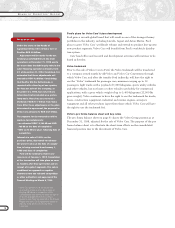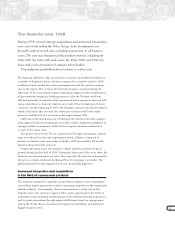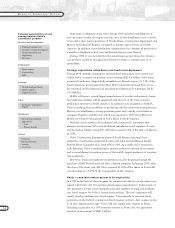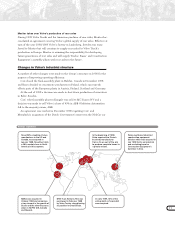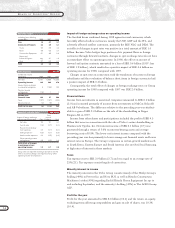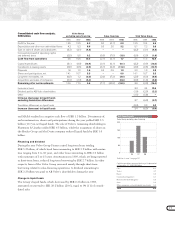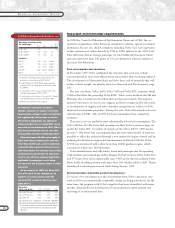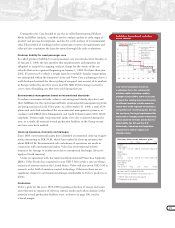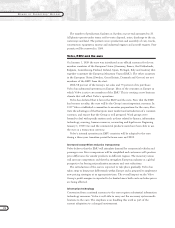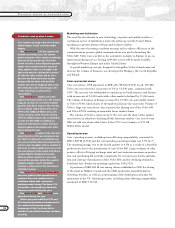Volvo 1998 Annual Report Download - page 20
Download and view the complete annual report
Please find page 20 of the 1998 Volvo annual report below. You can navigate through the pages in the report by either clicking on the pages listed below, or by using the keyword search tool below to find specific information within the annual report.
18
Research and development
Volvo and other transport vehicle manufacturers face several key challenges
moving into the next century, including the environment and traffic safety. The
most important are emissions of greenhouse gases, projected higher traffic
injuries, crowding and noise as well as health problems in urban areas caused by
poor air quality. Volvo’s core values – safety, quality and concern for the environ-
ment – are cornerstones in Volvo’s desire to develop products and services that
can meet these challenges.
Concept development and system integration
In view of the above challenges it is important to have a well balanced and
focused technical strategy. This means that the areas in which Volvo is focusing
its research efforts are being examined and evaluated continuously. This has
resulted in a more concentrated effort in a number of strategic areas where
Volvo aims to be, or already is, world-class. It has also resulted in R&D work
being concentrated on the development of concept vehicles in which different
systems can be integrated and tested from the point of view of customer
attitudes and functionality. Another trend involves focusing on system develop-
ment and integration, rather than the development of components, which is
being assigned to specialized joint-venture partners to an increasing degree.
Reduction of greenhouse gases
Reduction of fuel consumption has a very high priority within Volvo; the
objective is to reduce the amount of greenhouse gases and obtain a low life-cycle
cost, in particular for Volvo vehicles used in commercial traffic. This can be
achieved through new technology or the improvement of present technology,
primarily in the field of engines and peripheral equipment but also through
intensive programs to reduce weight and air resistance. Since there is no
complete solution that solves the problem in a cost-effective way, research has to
deal with all three aspects, applying both short- and long-term solutions. Over
the short and medium term, the focus is being placed mainly on improving the
combustion process by means of advanced systems, direct-injection, reducing
friction losses and introducing low-weight materials in components where this is
feasible. Long-term solutions could involve electric-powered hybrid vehicles or
vehicles powered by a fuel-cell system.
Volvo participates in several cooperation projects involving fuel cells and has
established its own laboratory for full scale trials and evaluation of various
systems. Since spring 1998, Volvo has been testing fuel cells in buses in the US
through the Nova BUS subsidiary. In June 1997 a project was concluded in
which Volvo, Renault and other cooperation partners supported by the EU
developed a car powered by fuel cells which is now being used for continued
tests. Another project involving Volvo, Renault and others was started in 1998.
Research and development expenses
2
6
4
0
SEK billion
96 97 98
Commercial Products
Cars
BOARD OF DIRECTORS’ REPORT
In a fuel cell, chemical energy is
converted to electrical energy continu-
ously as long as fuel is supplied, in the
same way as in a gasoline or diesel
engine. The similarities end there,
however, since fuel cells have a much
higher degree of efficiency, are powered
by hydrogen gas and emit only pure
water. This technology is still in the deve-
lopment stage and important questions
have to be solved before it can possibly
be introduced in applications in the auto-
motive industry.
Fuel cells
Output electric
motor
Air
Emissions
Air
Steam
Fuel
Recirculation
of fuel
Proton-emitting membrane (PEM)
Channels for
air flow
Channels for
fuel flow
Heat
Water cooling
1996 1997 1998
Cars 4.9 5.1 5.8
Commercial Products 3.3 3.5 4.2
Other 0.1 0.1 0.1
Total Volvo Group 8.3 8.7 10.1


